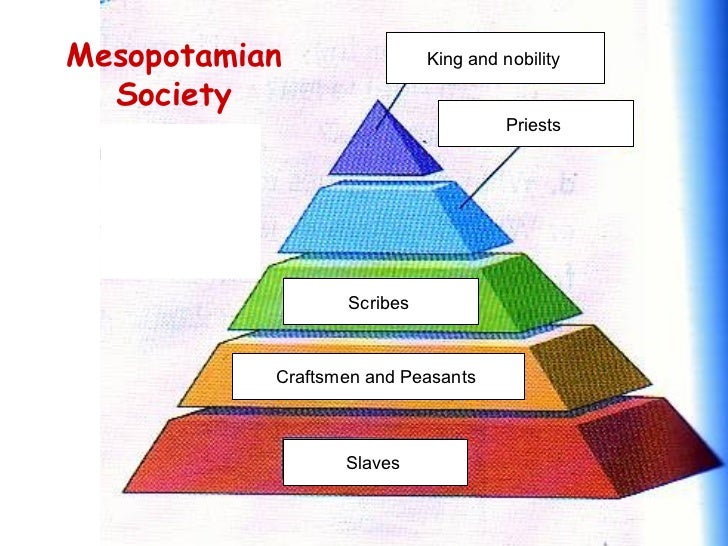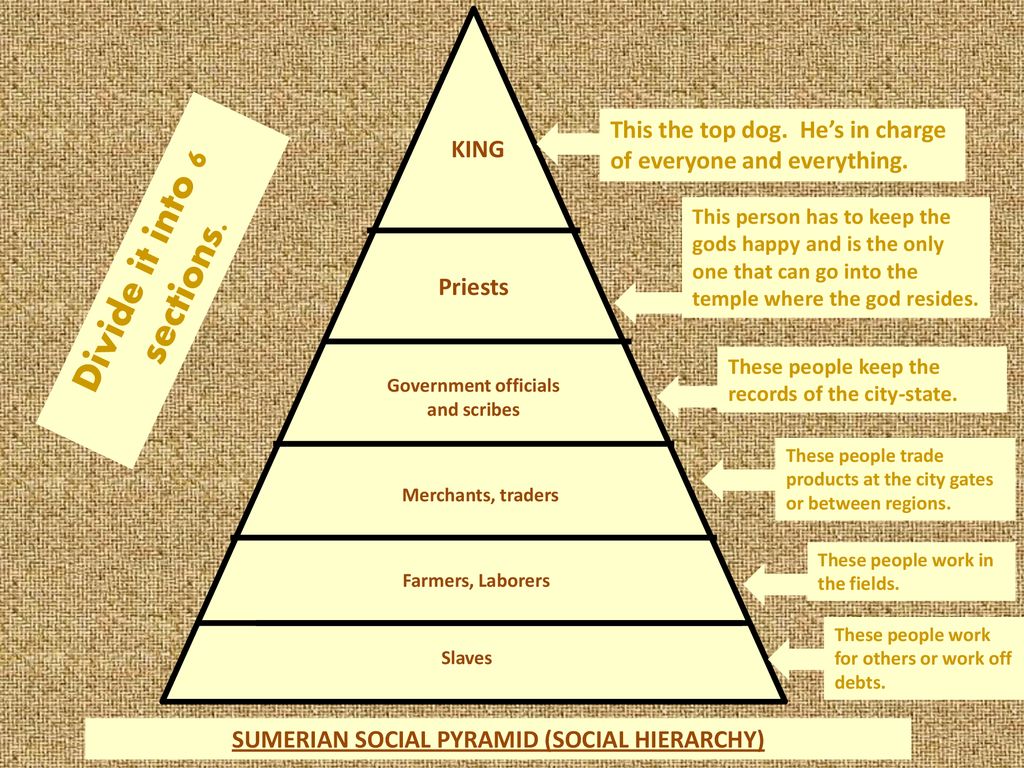Mesopotamia's Social Hierarchy: Unveiling Classes & Pyramid Structure!
Did you know that the ancient Mesopotamian society, a cradle of civilization, was meticulously organized, with its structure resembling a sharply defined pyramid? The intricate social hierarchy of Mesopotamia, a system that dictated roles, responsibilities, and the very fabric of daily life, offers a fascinating window into the past.
The social structure in ancient Mesopotamia was far from egalitarian; it was rigidly stratified. At the apex stood the king, considered a divine ruler, followed by a select group of nobles and priests who wielded significant power. Below them, the upper class, comprising scribes and merchants, enjoyed a privileged status. The middle class, consisting of farmers, laborers, and craftsmen, formed the bulk of the population, while at the very bottom, slaves endured a life of servitude.
The very essence of governance, economic organization, and social stability hinged on this distinctive hierarchical structure. This system was crucial for the smooth functioning of their society. The ruling class, which included kings and priests, held significant power and authority, while the majority of the population occupied lower tiers of the pyramid. The kings duties were vast, encompassing running the government, making laws, participating in religious rites, and overseeing the administration of justice.
- Securely Connect Remote Iot Devices With P2p Ssh On Raspberry Pi Guide
- Start Your Iot Journey Raspberry Pi Projects Setup Guide
Mesopotamia's social hierarchy, could be seen as the following class system:
- Royalty (King and Nobility): They were at the top of the pyramid, controlling the government, making laws, and overseeing religious practices.
- Upper Class: This class includes scribes and merchants, they are beneath the royalty, they perform the upper class work.
- Middle Class: Consisted of skilled workers, such as scribes, artists, and artisans.
- Lower Class: This class includes farmers, laborers, and craftsmen.
- Slaves: They were at the bottom of the social hierarchy and were forced to serve their masters.
The social structure of ancient Mesopotamia wasn't just a matter of status; it directly impacted every aspect of life. The higher one's position on the social ladder, the more access they had to resources, power, and influence. This stratification was evident in housing, clothing, diet, and even legal rights. The ruling class enjoyed lavish lifestyles, while the lower classes and slaves lived a far more modest existence, often struggling for survival.
To gain a clearer understanding, lets delve deeper into the roles and responsibilities of each class:
- The King and Nobility: The king, often viewed as a representative of the gods, held ultimate authority. He was responsible for maintaining order, providing justice, and overseeing religious rituals. The nobility, comprised of royal family members and high-ranking officials, assisted the king in governing and managing the kingdom's resources.
- The Upper Class (Scribes and Merchants): Scribes, highly respected for their literacy and knowledge, played a crucial role in recording transactions, writing legal documents, and copying religious texts. Merchants, involved in trade and commerce, facilitated the exchange of goods and contributed to the economy's prosperity.
- The Middle Class (Farmers, Laborers, and Craftsmen): Farmers cultivated the land and produced the food supply, laborers performed manual tasks, and craftsmen created various goods such as pottery, tools, and textiles. Their hard work and skills were essential for the functioning of society.
- The Slaves: Slaves, at the bottom of the hierarchy, were considered property and forced to serve their masters. They performed various tasks, including domestic labor, agricultural work, and construction. Their rights were limited, and their lives were often harsh.
The social class pyramid in Mesopotamia was a reflection of the societys values and priorities. Those with wealth, power, and influence held the highest positions, while those with the least were relegated to the lowest. This structure facilitated governance, economic organization, and social stability. The ruling class, which included kings and priests, held significant power and authority, while the majority of the population occupied lower tiers of the pyramid.
The intricate structure of Mesopotamia was a result of various factors, including economic prosperity, irrigation systems, and the development of agriculture. The availability of resources and the need for organized labor led to social stratification and the formation of distinct communities.
The social hierarchy was also influenced by the rise of cities and the need for specialized skills. Scribes, skilled workers, and merchants gained importance as urban centers flourished and trade networks expanded.
The Mesopotamian social hierarchy demonstrates how ancient societies were organized in ways that directly precede modern social stratification. It reflects how the king was the top rank holder of the mesopotamia social hierarchy, and the king was responsible for creating the laws.
One could become enslaved in several ways, including selling oneself into slavery to pay off a debt, being sold by a family member to relieve debt, being sold as punishment for crime, or being kidnapped and sold into slavery in another region. These slaves were at the bottom of the mesopotamia social structure pyramid.
The artificial irrigation system, which was instrumental in agricultural success, also led to social stratification and the formation of different communities, further cementing the hierarchical structure.
Social hierarchy and power dynamics, the rigid structure with clear divisions between the different classes, played a pivotal role. Power and authority were concentrated in the hands of the ruling class, particularly the king and nobility, who held political, economic, and religious power. This concentration of power influenced everything from resource allocation to the administration of justice.
Within the Sumerians, there was a certain social hierarchy structure which developed as a result of distinction in wealth among the people. Those who owned the maximum amounts of money were placed on the top of the pyramid whereas those who were not as affluent took up the lower levels.
While the social classes were largely fixed, there was some degree of social mobility, particularly for skilled workers and merchants. However, the vast majority of the population remained in their assigned social class.
The legacy of Mesopotamian social structure can be seen in later civilizations and modern societies. The concept of social hierarchy, with its inherent inequalities and power dynamics, has persisted throughout history. The study of ancient Mesopotamia provides valuable insights into the development of social organization, governance, and the challenges of creating a just and equitable society.
Ancient Mesopotamia's social structure formed the backbone of its ancient civilization, shaping societal organization, resource allocation, and cultural development. It was organized based on people's wealth and status.
The social structure pyramid in mesopotamia was a crucial aspect of ancient civilization, defining the roles and relationships within society. This hierarchical structure allowed for the organization of labor, governance, and social interactions that formed the backbone of mesopotamian life.
Mesopotamian society, much like the later Egyptian civilization, used a social structure pyramid. This was organized based on people's wealth. There were four sections of the pyramid. First and most important was the priest or king. Second, was the middle class, which included merchants, craftspeople, artisans, and metal workers. This class was used mostly.
Ancient Mesopotamia, a cradle of civilization, featured a complex social structure with distinct classes that shaped its society, demonstrating their social classes, nobles, and peasants. A diverse middle class encompassing merchants, artisans, and scribes; A lower class comprised of farmers, laborers, and servants; and enslaved individuals who formed the lowest tier.
Much of the stability of this system and the level of social class reflects on the level of the social class pyramid.
| Mesopotamian Social Hierarchy: Key Figures and Their Roles | |
|---|---|
| Category | Details |
| King |
|
| Nobility |
|
| Priests |
|
| Scribes |
|
| Merchants |
|
| Farmers, Laborers, Craftsmen |
|
| Slaves |
|
| Additional Information |
|
| Reference | Encyclopaedia Britannica: Mesopotamia |



Detail Author:
- Name : Ms. Lelia Kassulke
- Username : bmills
- Email : walker.dimitri@yahoo.com
- Birthdate : 2001-02-24
- Address : 87301 Pietro Stream Suite 680 West Bette, KY 90612-4855
- Phone : (480) 313-6057
- Company : Larson-Robel
- Job : City Planning Aide
- Bio : Qui perspiciatis dolorem repellat suscipit. Blanditiis ut ea sequi ut mollitia in. At voluptatum animi quo non cum numquam et.
Socials
instagram:
- url : https://instagram.com/esperanza1633
- username : esperanza1633
- bio : Quisquam illum est cum nam aliquid. Atque repellat et eum. Quas ut quia sed.
- followers : 2285
- following : 982
facebook:
- url : https://facebook.com/turnere
- username : turnere
- bio : Aspernatur sed ad porro qui facere.
- followers : 5598
- following : 237